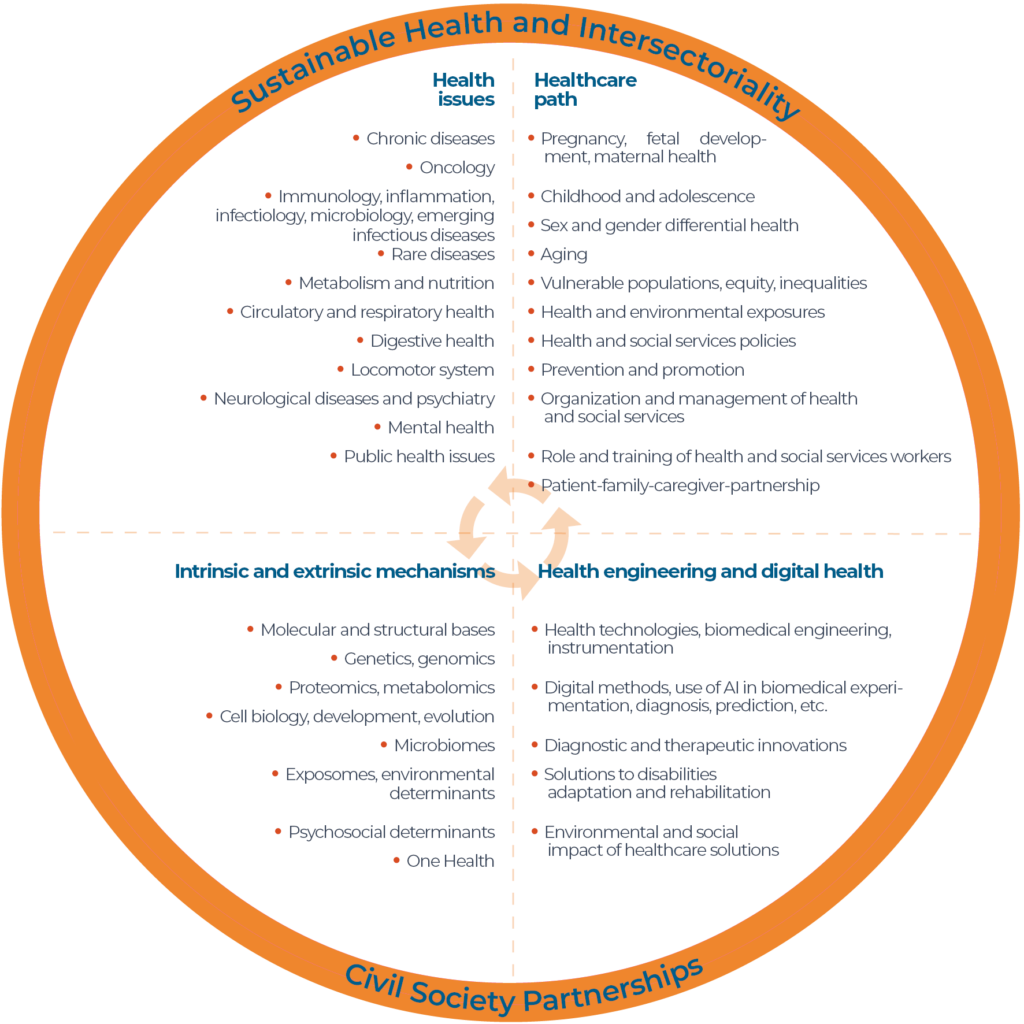Vision
Research that vibrates with society and its diversity, for sustainable health, an essential resource for individual development and socio-economic prosperity.
Research domains
The research fields have been revised and divided into four categories that fit into the four quadrants of the new conceptual framework illustrated by the circle below.
Each quadrant deals with health from a more specific perspective: from mechanisms to health disruptions, to health solutions, through systemic pressures on the individual and the community. The quadrants are porous and interact with each other, reflecting the cross-cutting, evolving and interconnected nature of the different fields of health research.
This conceptual framework should make it possible to better mobilize expertise (by inviting a broader research community to recognize itself as a contributor to one or more domains of the Health sector), to encourage intersectorial research and ultimately to transform results into concrete solutions for health and health systems challenges (two slightly different things) in a sustainable, accessible and equitable way.
Health issues
This quadrant groups together the major health challenges that mobilize health research, care and services. It retains a pathological nomenclature that is comprehensible to a large number of stakeholders (healthcare professionals, decision-makers, etc.). It is complete enough to reflect provincial, national and international priorities (chronic diseases; emerging infectious diseases). Research work covers the entire continuum, from pathophysiology, incidence, screening, diagnosis and treatment development to public policy.
- Chronic diseases
- Oncology
- Immunology, inflammation, infectiology, microbiology, emerging infectious diseases
- Rare diseases
- Metabolism and nutrition
- Circulatory and respiratory health
- Digestive health
- Locomotor system
- Neurological diseases and psychiatry
- Mental health
- Public health issues
Healthcare path
The focus here is on the trajectories of individuals and groups in their living environment and through the healthcare system, from the prenatal period through to aging. This quadrant will therefore make room for more specific windows of intervention over the life course, but also for social and environmental determinants (covering the natural environment – pollution, climate change – as well as the workplace, etc.) and their impact on health. It will also shed light on research addressing issues of equity and inclusion. Finally, it brings together research that looks at the design and evolution of health services, not just in the health system, by integrating different roles and actors.
- Pregnancy, fetal development, maternal health
- Childhood and adolescence
- Sex and gender differential health
- Aging
- Vulnerable populations, equity, inequalities
- Health and environmental exposures
- Health and social services policies
- Prevention and promotion
- Organization and management of health and social services
- Role and training of health and social services workers
- Patient-family-caregiver partnership
Intrinsic and extrinsic mechanisms
This category covers research aimed at understanding the internal and external factors that influence health and pathological transitions. This includes fundamental research on the basics of life (molecular, genetic, cellular), as well as research into environmental, social and behavioral and other determinants. Fields of research such as microbiomes or exposomes are named, appearing as some connectors between “inside” and “outside” the human body. Finally, “one health” is also mentioned here: while the field of research is extremely broad and certainly highly interdisciplinary, it is a reminder that human health research must integrate interrelations with environmental health and biodiversity.
- Molecular and structural bases
- Genetics, genomics
- Proteomics, metabolomics
- Cell biology, development, evolution
- Microbiomes
- Exposomes, environmental determinants
- Psychosocial determinants
- One Health
Health engineering and digital health
This quadrant covers technological, social and organizational research and innovation in support of healthcare practices (inside and outside the healthcare system). It includes biomedical engineering, medical devices, the development of innovative therapies, computational approaches, and even innovations aimed at precision medicine (development of tools and implementation). It also includes research aimed at the eco-responsibility of healthcare technologies.
- Health technologies, biomedical engineering, instrumentation
- Digital methods, use of AI in biomedical experimentation, diagnosis, prediction, etc.
- Diagnostic and therapeutic innovations
- Solutions to disabilities, adaptation and rehabilitation
- Environmental and social impact of healthcare solutions

